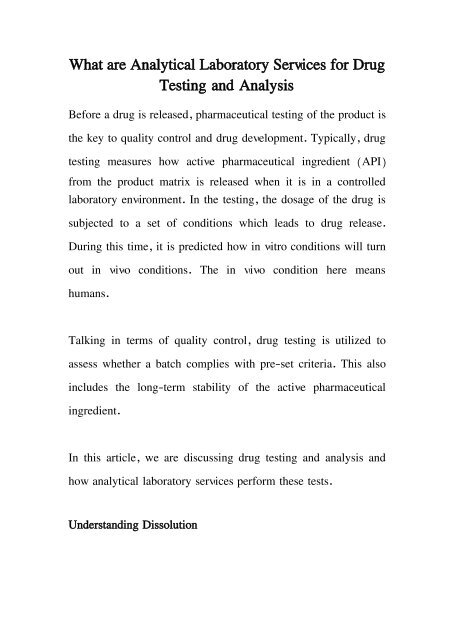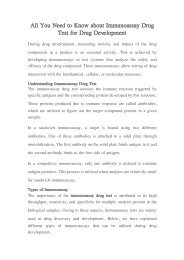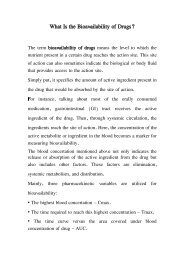What are Analytical Laboratory Services for Drug Testing and Analysis
Before a drug is released, pharmaceutical testing of the product is the key to quality control and drug development. Typically, drug testing measures how active pharmaceutical ingredient (API) from the product matrix is released when it is in a controlled laboratory environment.
Before a drug is released, pharmaceutical testing of the product is the key to quality control and drug development. Typically, drug testing measures how active pharmaceutical ingredient (API) from the product matrix is released when it is in a controlled laboratory environment.
- TAGS
- dissolution
You also want an ePaper? Increase the reach of your titles
YUMPU automatically turns print PDFs into web optimized ePapers that Google loves.
<strong>What</strong> <strong>are</strong> <strong>Analytical</strong> <strong>Laboratory</strong> <strong>Services</strong> <strong>for</strong> <strong>Drug</strong><br />
<strong>Testing</strong> <strong>and</strong> <strong>Analysis</strong><br />
Be<strong>for</strong>e a drug is released, pharmaceutical testing of the product is<br />
the key to quality control <strong>and</strong> drug development. Typically, drug<br />
testing measures how active pharmaceutical ingredient (API)<br />
from the product matrix is released when it is in a controlled<br />
laboratory environment. In the testing, the dosage of the drug is<br />
subjected to a set of conditions which leads to drug release.<br />
During this time, it is predicted how in vitro conditions will turn<br />
out in vivo conditions. The in vivo condition here means<br />
humans.<br />
Talking in terms of quality control, drug testing is utilized to<br />
assess whether a batch complies with pre-set criteria. This also<br />
includes the long-term stability of the active pharmaceutical<br />
ingredient.<br />
In this article, we <strong>are</strong> discussing drug testing <strong>and</strong> analysis <strong>and</strong><br />
how analytical laboratory services per<strong>for</strong>m these tests.<br />
Underst<strong>and</strong>ing Dissolution
To know how dissolution is used to find out the changes in the<br />
per<strong>for</strong>mance of drugs, underst<strong>and</strong>ing the process is important.<br />
Read on to know how dissolution works:<br />
For most of the oral drugs that we consume, the absorption of<br />
API is necessary <strong>for</strong> systemic circulation as it helps in taking the<br />
API to the site of action. This whole process is divided into two<br />
parts, dissolution <strong>and</strong> permeability or absorption. During the<br />
dissolution phase, the solid <strong>for</strong>m of the drug is extracted in<br />
solution <strong>for</strong>m in the GI tract. Then, during absorption, the drug<br />
substance is taken to the systemic circulation.<br />
In vitro studies analyze how API converts from solid dosage,<br />
which is the crux of evaluating the efficiency of drug substance<br />
in in vivo <strong>for</strong>m.<br />
<strong>Drug</strong> <strong>Testing</strong> by <strong>Analytical</strong> <strong>Testing</strong> <strong>Services</strong><br />
To assess the manufacturing stability <strong>and</strong> quality of drug product,<br />
in vitro drug dissolution studies <strong>are</strong> carried out by the analytical<br />
services laboratory. Some of these methods used <strong>for</strong> drug testing<br />
<strong>are</strong> explained below:<br />
Oral Dosage <strong>Testing</strong>: This In vitro testing assesses how an<br />
oral drug product goes into solution <strong>for</strong>m per unit time when it is
subjected to st<strong>and</strong>ardized conditions. The major goal of this type<br />
of dissolution is to check the bioavailability of the drug. Apart<br />
from this, the oral dosage dissolution also tests how safe the drug<br />
product is <strong>and</strong> what is the influence of manufacturing process<br />
variance on the drug.<br />
Transdermal <strong>and</strong> Topical In Vitro Release <strong>Testing</strong>: A<br />
vertical diffusion cell is utilized to underst<strong>and</strong> the API release in<br />
case of transdermal <strong>and</strong> topical products. The product is placed<br />
such that it is in contact with the membrane, which, in turn, is in<br />
contact with the receiving medium. The receiving medium is<br />
basically a time function. The membrane is made of animal skin,<br />
cadaver, synthetic polymer, <strong>and</strong> tissue constructs. This technique<br />
is useful <strong>for</strong> topical <strong>for</strong>mulations that <strong>are</strong> externally applied along<br />
with products used <strong>for</strong> rectal, vaginal, <strong>and</strong> nasal routes.<br />
Elution <strong>Testing</strong>: Elution testing is carried out <strong>for</strong> a<br />
drug-device combination, in which, how the drug leaves the<br />
device is evaluated. This is achieved by placing the device<br />
containing a drug into a suitable medium. In the elution test, the<br />
medium choice, exchange frequency, <strong>and</strong> test volumes depend on<br />
the device's nature.
It is necessary <strong>for</strong> dissolution or drug testing to choose the right<br />
testing condition in accordance with the drug medium <strong>for</strong> a<br />
desirable outcome. The correct execution of in vitro is essential<br />
<strong>for</strong> simulating the nearly similar impact of the drug in the in<br />
vivo conditions.





